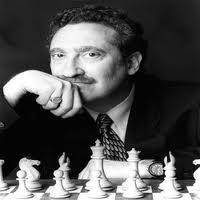
Pandolfini's Puzzler #14 - The Day After Halloween
“Did you have a nice Halloween?” the Professor asked both Zephyr and Lucian who, once again, were in class together.
---
Both of the Professor’s prized students nodded in agreement.
---
The Professor continued: “I’m curious. What did you do last night and did you get dressed up?”
---
This time, Lucian beat Zephyr in response.
---
“I went around trick-or-treating, and I was dressed up as Dracula. I got a lot of candy.”

---
“And you, Zephyr?”
---
“Oh, I got a lot of candy, too. I was Dorothy. You know, from 'The Wizard of Oz.' I guess I wasn’t as frightening as Lucian.”
---
“Well, I can see that both of you are tired from being up late last night. Are you awake enough to tackle a puzzle?”
---
Naturally, Zephyr and Lucian were eager to be challenged, so they shook their heads “yes.”
---
“Okay, then,” the Professor said. “Please consider the following position before I explain.”
---
---
“It’s claimed that the above position was set up on a university student’s chessboard when he woke up in his dormitory the morning after Halloween. Supposedly, it was the final position of a game the young man lost to the mysterious Dr. Death.”
---
“Dr. Death?” Lucian asked.
---
“Yes,” said the Professor, “and he was dressed as a skeleton, his real face hidden. The student never found out who he really was.”
---
Zephyr got it back to the board: “Black is already checkmated, but the situation seems impossible.”
---
“Well, that brings us to our question,” the Professor chimed in.
---
Question: Is this position legal? And, if so, how did it come about?

---
Both Zephyr and Lucian were confused. They didn’t see how the bishop could give a check from b1.
---
“I can’t see how the bishop was able to give check,” said Zephyr. “Where did the bishop come from?”
---
Lucian had his concerns, too. “I was trying to find a discovered check, but the f-pawn couldn’t have come from f5. If it had, that would mean the f-pawn was already checking the black king, so f5-f6 would have been illegal.”
---
“Quite right,” the Professor agreed. “Let me give you just a bit of a clue,” the Professor warmly said. "You’re right, of course, Lucian. The f-pawn couldn’t have come from f5. So where did it come from? Answer that and you have the big answer.”
---
That apparently was the trigger the two students needed. It started them thinking, and after a minute or so, they looked at each other. It was obvious they had both figured out something important.
---
How did the f6 pawn get there? And what was the preceding setup leading to the first diagram?
---
Answers below - Try to solve Professor Pando's puzzle first!
---
ANSWER #14
---
Diagram 2 shows what the original position was.
---
---
In the position of diagram 2, White plays 1. e5+. Black then has only one move, which is 1…f5. But that allows White to play 2. exf6, en passant and mate!
---
So the position was legal. Whether or not Dr. Death actually played it, well, that’s another matter. Whether or not Dr. Death really existed, well . . . who knows?
---
Take note
---
This type of problem, where one has to work backward to try to explain how a particular position came about, is known as retrograde analysis. Thinking backward can be helpful in lots of situations. For example, a good chess detective can often ascertain what the opening might have been by an examination of the middlegame pawn structure. Some players can even look at an endgame and still determine or intelligently guess what the opening might have been. True, some can't.
---
RELATED STUDY MATERIAL
- GracefulLady shows you when to play en passant, and when to forget it;
- Pink Hamster's video details the history of the strange rule;
- Then he asks you to solve some ingenious puzzles with en passant!






